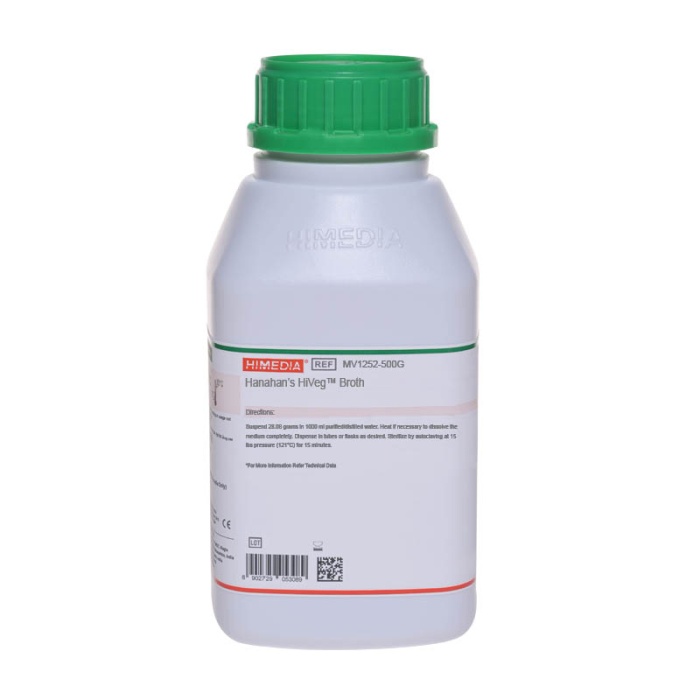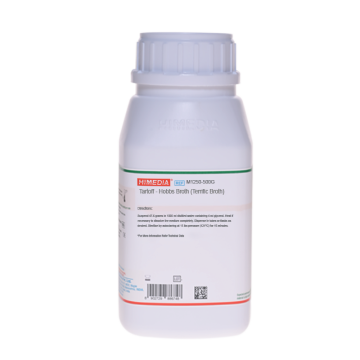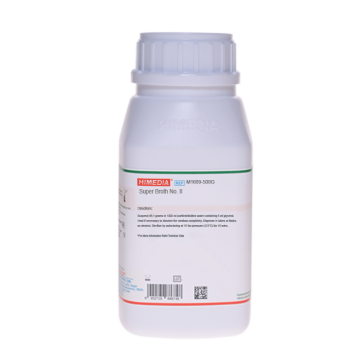 Your enquiry has been submitted
Your enquiry has been submitted
Hanahan’s Broth (SOB Medium)
Molecular Biology#CC293D
Intended Use
Recommended for use in cultivation of recombinant strains of Escherichia coli.
Composition
| Ingredients | Gms / Litre |
|---|---|
| Tryptone | 20.000 |
| Yeast extract | 5.000 |
| Sodium chloride | 0.500 |
| Magnesium sulphate | 2.400 |
| Potassium chloride | 0.186 |
Final pH (at 25°C): 7.0±0.2
**Formula adjusted, standardized to suit performance parameters
Directions
Suspend 28.08 grams in 1000 ml purified/distilled water. Heat if necessary to dissolve the medium completely. Dispense in tubes and sterilize by autoclaving at 15 lbs pressure (121°C) for 15 minutes.
Principle And Interpretation
Transformation is a process involving the uptake of foreign genetic material, which on subsequent recombination event results into genetically altered cell. The ability of a bacterium to take up exogenous DNA from the extracellular environment is termed as competence of the bacterium. Factors affecting the cell surface are important to competence, particularly changes in the membrane permeability, so as to allow the foreign DNA to enter the recipient cell (1). Bacteria undergoing transformation need to be cultured on a rich, isotonic medium to overcome or recover from the process of transformation by mending the perforations caused by transformation and undergo replication (5). Hanahans Broth developed by Hanahan (2) is used for the cultivation of these recombinant Escherichia coli strains that have undergone transformation.
Hanahans Broth is a nutritionally rich growth medium for use in the preparation and transformation of competent cells. For generation of competent cells, the bacteria is grown in Hanahans Broth to the desired turbidity and subjected to standard procedures such as electroporation or treatment with CaCl2 in chilled conditions to achieve competence. For the survival of such perforated, competent cells, a rich, isotonic environment is needed. Hanahans Broth with 0.4% dextrose is used in the final stage of transformation, which provides carbon and energy source for mending the perforations and subsequent replication (5).
Tryptone and yeast extract in the medium supply nitrogenous compounds and growth factors for the recombinant E. coli. Potassium and sodium chloride maintains isotonic conditions. Magnesium sulphate is added to the medium as the necessary component for DNA replication.
Type of specimen
Isolated Recombinant Escherichia coli
Specimen Collection and Handling:
For isolated microorganism samples follow appropriate techniques for handling specimens as per established guidelines (1,2,5).
After use, contaminated materials must be sterilized by autoclaving before discarding.
Warning and Precautions :
Read the label before opening the container. Wear protective gloves/protective clothing/eye protection/ face protection. Follow good microbiological lab practices while handling specimens and culture. Standard precautions as per established guidelines should be followed while handling specimens. Safety guidelines may be referred in individual safety data sheets.
Limitations :
- This medium is general purpose medium and may not support the growth of fastidious organisms.
- Further biochemical and serological tests must be carried out for further identification.
Performance and Evaluation
Performance of the medium is expected when used as per the direction on the label within the expiry period when stored at recommended temperature.
Quality Control
Appearance Cream to yellow homogeneous free flowing powder
Colour and Clarity of prepared medium Medium amber coloured, clear solution without any precipitate
Reaction Reaction of 2.8% w/v aqueous solution at 25°C. pH : 7.0±0.2
pH 6.80-7.20
Cultural Response Cultural characteristics observed after an incubation at 35-37°C for 18-24 hours.
| Organism | Inoculum (CFU) | Growth |
|---|---|---|
| Escherichia coli DH5 53868 | 50-100 | good-luxuriant |
Storage and Shelf Life
Store between 10-30°C in a tightly closed container and the prepared medium at 15-25°C. Use before expiry date on the label. On opening, product should be properly stored dry, after tightly capping the bottle in order to prevent lump formation due to the hygroscopic nature of the product. Improper storage of the product may lead to lump formation. Store in dry ventilated area protected from extremes of temperature and sources of ignition. Seal the container tightly after use. Product performance is best if used within stated expiry period.
Disposal
User must ensure safe disposal by autoclaving and/or incineration of used or unusable preparations of this product. Follow established laboratory procedures in disposing of infectious materials and material that comes into contact with sample must be decontaminated and disposed of in accordance with current laboratory techniques (3,4).
Reference
- Alcamo I. E., 2001, Fundamentals of Microbiology, 6th Edition, Jones and Bartlett Publishers.
- Hanahan D., 1983, J. Mol. Biol., 166:557.
- Isenberg, H.D. Clinical Microbiology Procedures Handbook 2nd Edition.
- Jorgensen, J.H., Pfaller, M.A., Carroll, K.C., Funke, G., Landry, M.L., Richter, S.S and Warnock., D.W. (2015) Manual of Clinical Microbiology, 11th Edition. Vol. 1.
- Sambrook J., Fritsch E. E. and Maniatis T., 1989, Molecular Cloning: A Laboratory Manual, 2nd Ed., Cold Spring Harbor Lab. Press; Cold Spring Harbor, N.Y.
| Product Name | Hanahan’s Broth (SOB Medium) |
|---|---|
| SKU | M1252 |
| Product Type | Regular |
| Physical Form | Powder |
| Origin | Animal |
| Packaging type | HDPE |
| References | 1.Alcamo I. E., 2001, Fundamentals of Microbiology, 6th Edition, Jones and Bartlett Publishers.2.Sambrook J., Fritsch E. E. and Maniatis T., 1989, Molecular Cloning : A Laboratory Manual, 2nd Ed., Cold Spring Harbor Lab. Press; Cold Spring Harbor, N.Y.3.Hanahan D., 1983, J. Mol. Biol., 166:557. |
| Customized Product Available | No |












